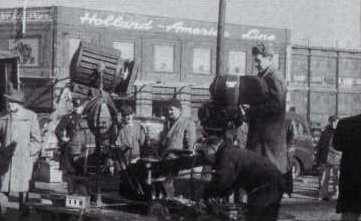 |
 Location: The Local Players
Location: The Local Players
Before filming began, Mayor John Grogan appointed municipal employee Tony D'Amato as the city's official liaison with the production company. Among this one-man film commission's accomplishments was to get scores of Hobokenites into the movie. Just about everyone who lived in Hoboken in the early 1950s has a story about a family member who was -- or almost was -- in the movie. New York Times reporter Anthony DePalma, Jr. has told the story that his father had an opportunity to have his legs fill in for Brando's in the climactic scene in which Terry staggers up to the gate of the pier. DePalma Senior refused because, on the piers, he was known as "Tony-All-The-Time," and nothing so trifling as the prospect of a screen debut was going to break his perfect attendance record. DePalma Junior is quick to add that his uncle's truck did appear in the movie. (Sure enough, the truck cruises down Willow in the background of the second Church Square Park scene, just ahead of the prop truck.)
Then there was Jimmy Francis, a longshoreman and ex-fighter who lost three bouts with Jimmy Braddock before Braddock became heavyweight champion. According to a "Coach's Corner" column by Larry Babich in the Jersey Journal, Francis actually taught the great Brando a thing or two about how to walk after absorbing a beating. Apparently, Kazan remained dissatisfied with three takes of the scene in which Brando totters up the ramp from the yacht club after being worked over by Friendly's torpedoes. When Francis bounded out of the assembled work gang, did a perfect recreation of a rubber-legged fighter, and fell to the ground, the crown loved it. More to the point, so did Kazan, who told Brando to copy what Francis had done. The consummate Method actor, of course, complied.
Many of those who did appear in the movie were just faces in the work gangs. A few of those went on to minor careers as actors. Retired longshoreman Anthony Amato, an extra in On the Waterfront, has had non-speaking parts in The Godfather and Donnie Brasco.
Longshoreman Johnny Sanducci is only a face in the crowd, but his jacket played a more prominent role. (He also had a bit part as one of Vito Corleone's bodyguards in the wedding scene in The Godfather.) It was Sanducci's garment that passed from Joey to Dugan to Terry as a symbolic passing of the mantle from hero to hero (or from cheese-eater to cheese-eater, if you prefer to think of them as rats).
Some Hobokenites were more than extras in the film. One was Mike Rubino, then a longshoreman and still a local resident. As the bridegroom in the wedding reception, Rubino tells his wife, "You gotta stop smokin' so much."
Another was Pete King. All the police officers in the film were actual members of the Hoboken Police Department. King, the cop who restrains Friendly from attacking Terry during the Crime Commission hearing, gets to speak moments later. When Terry complains, in the hallway of Edie's building, that having two cops accompany him everywhere makes him uncomfortable, King replies, "You ought to be glad we're following you."
Frank Marnell, a Rue School gym teacher at the time, drew the enviable, if nameless, role of the Mr. Big who turns off his television set in the middle of the Crime Commission hearing, and instructs a servant that he is not in for Mr. Friendly -- ever again. Marnell reappears in front of Pier C as Terry lurches toward the door and his own self-respect. Hands in the pocket of his overcoat, the prepossessing Marnell utters the words that give Terry his victory and seals Friendly's fate -- "All right. Let's go to work" -- just before "The End" appears on the screen and the gate closes.
During the first shape-up, Matty Russo asks the plaintive question that summarizes the plight of the longshoremen, "Hey, who do you have to see to get a day's pay around here?" Later, he precipitates the fight at the wedding reception when he tries to kiss the bride in a more than congratulatory way. Russo, still known around town as "John Wayne," went on to a 40-year career as a character actor, appearing most prominently in The Seven-Ups, a 1973 unofficial sequel to The French Connection.
The biggest part awarded to a local was that of the 12- or 13-year old Tommy, which went to local teenager Tommy Hanley. Tommy is Terry's acolyte, helping to care for his pigeons, imitating his swagger, and succeeding him as leader of the Golden Warriors. Appearing in four of the five rooftop scenes, he has two memorable lines. Obviously disgusted that his hero is interested in something as insignificant as a girl, Tommy corrects Edie's identification of one of the bird's gender. "He's a she. His name is Swifty," he chastens her with evident disdain. Later, distraught over Terry's appearance before the Crime Commission, Tommy, who has killed all the birds, throws one of them -- presumably Swifty -- at Terry. "A pigeon for a pigeon," Tommy screams through his tears of disappointment.
Finally, no discussion of Hoboken and On the Waterfront would be complete without mentioning "Tony Mike" DiVincenzo, who may or may not have been the prototype of Terry Malloy. While many commentators have doubted that Budd Schulberg had ever heard of him, DiVincenzo had, in fact, testified before a real-life Waterfront Commission on the facts of life on the Hoboken docks; had, in fact, suffered a degree of ostracization for his deed; sued Columbia Pictures over the appropriation of what he considered his story; and settled out of court for $25,000.



|
|
 |